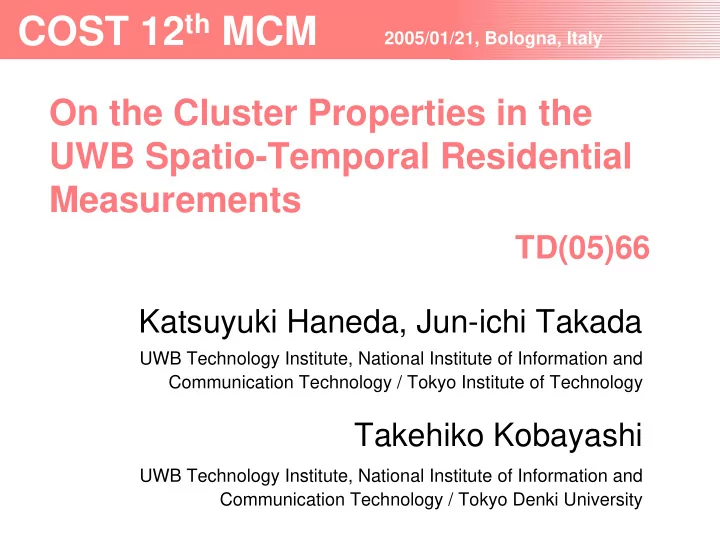

COST 12 th MCM 2005/01/21, Bologna, Italy On the Cluster Properties in the UWB Spatio-Temporal Residential Measurements TD(05)66 Katsuyuki Haneda, Jun-ichi Takada UWB Technology Institute, National Institute of Information and Communication Technology / Tokyo Institute of Technology Takehiko Kobayashi UWB Technology Institute, National Institute of Information and Communication Technology / Tokyo Denki University
Table of contents • Environments under consideration • Analyses of the measured data • Channel parameters and its physical interpretation • Summary • Acknowledgement
Environments under consideration • “Representative channels” 1. LOS room 2. OLOS Room-corridor 3. NLOS Room-corridor 4. NLOS Inter-room 5. NLOS Inter-floor 6. OLOS Indoor-outdoor 7. NLOS Indoor-outdoor • Small number of measurements for stochastic analyses • Not achieved continuous measurements
Analyzing the measured data 1. Path extraction – SAGE algorithm – 100 waves 2. Clusterization of the paths – In spatio-temporal (DOA-TOA) domain – With a heuristic approach 3. Analyses of clusters – These clusters are not considered: a. Power is less than 1% of the total received power, and b. The number of paths is less than 5 – Channel parameters
Channel parameters 1. Number of clusters 2. Number of paths in each cluster 3. Standard deviation of the path distribution within clusters w.r.t. azimuth / delay 4. Cluster power ratio 5. Percentage of the sum of extracted power by the discrete components 6. Relative power of the diffuse paths
Channel parameters (1) 1. The num. of clusters / the num. of paths in each cluster N N cluster path 7 3 ~ 24 LOS room 6 5 ~ 23 OLOS room-corridor 6 3 ~ 27 NLOS room-corridor 8 6 ~ 20 NLOS inter-room 3 ~ 25 10 NLOS inter-floor 15 ~ 40 3 OLOS indoor-outdoor 3 21 ~ 26 NLOS indoor-outdoor
Physical interpretation (1) • Paths in the NLOS inter-floor measurement
Physical interpretation (2) • Indoor-outdoor meas. Tx Metal shutter Rx
Channel parameters (2) 2. Standard deviation of paths in azimuth / delay domains σ σ [deg] [ns] φ τ 1.9 ~ 4.5 0.95 ~ 1.38 LOS room 2.4 ~ 6.7 0.54 ~ 1.51 OLOS room-corridor 0.9 ~ 6.4 0.64 ~ 1.65 NLOS room-corridor 1.8 ~ 6.3 0.21 ~ 1.28 NLOS inter-room 3.0 ~ 18.2 0.07 ~ 1.28 NLOS inter-floor 3.1 ~ 7.6 0.15 ~ 2.30 OLOS indoor-outdoor 2.1 ~ 7.1 0.10 ~ 2.07 NLOS indoor-outdoor
Channel parameters (3) 3. Cluster power ratio / extracted power by 100 waves K PCT [dB] [%] cluster − 73.4 2 . 3 LOS room − 50.2 3 . 6 OLOS room-corridor − 50.2 2 . 5 NLOS room-corridor 66.8 0 . 0 NLOS inter-room − 50.6 3 . 7 NLOS inter-floor 9.6 73.8 OLOS indoor-outdoor 7.4 81.3 NLOS indoor-outdoor
Channel parameters (4) 4. Relative power of diffuse paths / extracted power by 100 waves / P strong P [dB] PCT [%] diffuse 39.6 73.4 LOS room 34.1 50.2 OLOS room-corridor 33.9 50.2 NLOS room-corridor 39.1 66.8 NLOS inter-room 29.4 50.6 NLOS inter-floor 35.6 73.8 OLOS indoor-outdoor 37.6 81.3 NLOS indoor-outdoor
Summary • Representative channel characterization by several parameters – Most of the representative (strongest) paths in each cluster are specular reflection / diffraction • Extension of the analyses to consider the DODs • For the stochastic analyses (Final Report) – Channel data interpolation using the ray-tracing – Searching for literatures of residential channel parameters • Double directional • Full-polarimetric
Acknowledgement • The authors would like to thank the members of UWB Technology Institute, NICT, Japan. – Prof. Dr. Kiyomichi – Dr. Makoto Yoshikawa Araki – Dr. Akira Akeyama – Mr. Iwao Nishiyama – Dr. Osamu Sasaki – Dr. Honggang Zhang – Mr. Fumio Ohkubo – Dr. Yuko Rikuta – Mr. Takahiro Miyamoto
Physical interpretation (3) • Indoor-outdoor scenarios – The strongest cluster carries most of the propagating power PCT K – Large and cluster • LOS scenario – Contribution of power from scattered paths is large due to effective illumination of scattering objects by the Tx and Rx PCT K – Large (but small ) cluster • NLOS (OLOS) scenarios – The environment are often more diffuse in which huge number of weak paths aggregate K – Small and PCT cluster
Recommend
More recommend